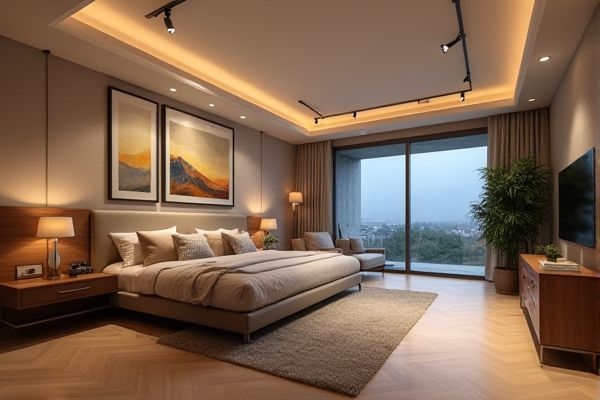
Track lighting offers flexible, adjustable illumination ideal for highlighting artwork or specific areas, while recessed lighting provides a sleek, unobtrusive look for general ambient light. Explore the rest of the article to decide which lighting option best suits your space and style needs.
Table of Comparison
| Feature | Track Lighting | Recessed Lighting |
|---|---|---|
| Installation | Surface-mounted, easier to install | Installed into ceiling, requires cutting and more effort |
| Flexibility | Adjustable heads, easy repositioning | Fixed position, limited adjustability |
| Lighting Style | Accent, task, and directional lighting | Ambient and general lighting |
| Appearance | Visible tracks, industrial look | Flush with ceiling, clean and minimalist |
| Cost | Moderate, less labor-intensive | Higher, installation complexity increases cost |
| Maintenance | Easy bulb replacement and repositioning | Harder to access, more effort to replace bulbs |
| Energy Efficiency | Depends on bulb type, often LED compatible | Often LED integrated, energy efficient |
Introduction to Track Lighting and Recessed Lighting
Track lighting features adjustable fixtures mounted on a continuous track, providing flexible illumination ideal for highlighting artwork or specific areas. Recessed lighting, installed flush with ceilings, offers a clean, minimalist look while delivering ambient light without intruding on the room's design. Your choice between these two depends on the desired lighting effect and architectural style of the space.
Design and Aesthetic Differences
Track lighting offers a flexible, contemporary design ideal for highlighting artwork or specific areas with adjustable fixtures mounted on a visible track, adding an industrial or modern aesthetic. Recessed lighting provides a sleek, minimalist look by being installed flush with the ceiling, maintaining clean lines and an unobtrusive appearance, which is perfect for creating ambient or general lighting. Choosing between the two depends on whether the design prioritizes customizable spotlighting or a seamless, integrated light source.
Installation Process and Requirements
Track lighting installation requires mounting a track on the ceiling and connecting it to an existing power source, offering flexibility in positioning individual fixtures along the track. Recessed lighting involves cutting precise holes into the ceiling and installing housing units, often requiring access to the space above the ceiling for wiring and a proper structural framework to support the fixtures. Both systems demand electrical knowledge, but track lighting is generally easier and faster to install, while recessed lighting offers a cleaner look with more complex installation requirements.
Flexibility and Adjustability
Track lighting offers superior flexibility and adjustability by allowing multiple light fixtures to be repositioned and aimed in different directions along the track, ideal for highlighting artwork or specific areas. Recessed lighting provides a clean, minimalistic look but lacks the ability to easily adjust the angle or position of individual lights once installed. For spaces requiring dynamic lighting solutions, track lighting delivers customizable illumination, whereas recessed lighting suits fixed, ambient lighting needs.
Light Distribution and Coverage
Track lighting offers flexible light distribution with adjustable fixtures that can be directed to highlight specific areas or objects, providing targeted coverage ideal for accent or task lighting. Recessed lighting delivers a more uniform and widespread illumination by being installed within the ceiling, creating an even light coverage suitable for general ambient lighting. Choosing between track and recessed lighting depends on the need for focused spotlighting versus broad, seamless light dispersion in a space.
Energy Efficiency Considerations
Track lighting offers flexibility in directing beams and typically uses energy-efficient LED bulbs that reduce power consumption while enhancing illumination control. Recessed lighting provides a sleek, integrated look with similarly energy-saving LED options, often leading to lower heat output and improved energy conservation in modern fixtures. Your choice between the two should weigh the impact on energy usage based on fixture placement, bulb types, and lighting needs to maximize efficiency.
Cost Comparison: Upfront and Maintenance
Track lighting typically has a lower upfront cost compared to recessed lighting, as it requires less labor for installation and does not necessitate ceiling modifications. Maintenance expenses for track lighting can be higher due to exposed bulbs that need more frequent cleaning and replacement. Recessed lighting, while more expensive to install due to drywall work and electrical adjustments, benefits from lower maintenance costs because of its protected fixture design and longer-lasting bulbs.
Best Use Cases for Track Lighting
Track lighting excels in spaces requiring flexible, directional illumination such as art galleries, kitchens, and retail displays. It allows adjustable light positioning to highlight specific areas or objects, supporting dynamic lighting needs. Ideal for rooms with varying lighting tasks, track systems provide customizable, focused brightness where needed most.
Ideal Scenarios for Recessed Lighting
Recessed lighting is ideal for creating a clean, modern look in spaces with low ceilings or where minimal visual distraction is desired. It provides even, ambient illumination perfect for kitchens, bathrooms, and hallways, enhancing both functionality and aesthetics. Your rooms can benefit from this subtle lighting style when you want to highlight architectural features or maintain an uncluttered ceiling.
How to Choose the Right Option for Your Space
Track lighting offers flexibility with adjustable heads that direct light where needed, making it ideal for highlighting artwork or task areas in your space. Recessed lighting provides a sleek, unobtrusive look perfect for general ambient lighting and low-ceiling rooms. Choosing the right option depends on your room's layout, ceiling height, and whether you prefer focused illumination or a clean, minimalist aesthetic.
 homyna.com
homyna.com